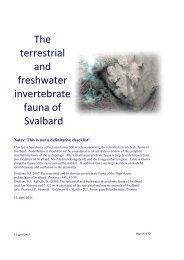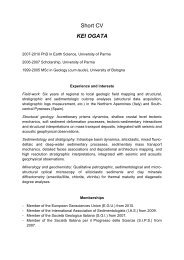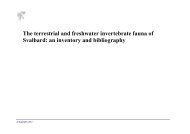Arctic plant ecology: From tundra to polar desert in Svalbard - Unis
Arctic plant ecology: From tundra to polar desert in Svalbard - Unis
Arctic plant ecology: From tundra to polar desert in Svalbard - Unis
You also want an ePaper? Increase the reach of your titles
YUMPU automatically turns print PDFs into web optimized ePapers that Google loves.
Life <strong>in</strong> the <strong>Arctic</strong> – a struggle for survival?<br />
Simone Lang 1 , Merete Wiken Dees 2 and Kathr<strong>in</strong> Bockmühl 3<br />
1 Systems Ecology, Faculteit der Aard en Levenswetensschappen, Vrije Universiteit Amsterdam, De<br />
Boelelaan 1085, NL1081 HV Amsterdam, The Netherlands, simone.lang@<strong>ecology</strong>.falw.vu.nl,<br />
2 Institutt for <strong>plant</strong>e og miljøvitenskap, Universitetet for miljø og biovitenskap, NO1432 Ås, Norway,<br />
mwdees@student.umb.no, 3 Department of biology, University of Bergen, Allégaten 41, NO5001<br />
Bergen, Norway, kathr<strong>in</strong>.bockmuhl@student.uib.no<br />
Abstract<br />
Are widespread <strong>plant</strong>s <strong>in</strong> the <strong>Arctic</strong> widespread due <strong>to</strong> their wide ecological amplitude<br />
or due <strong>to</strong> a widespread habitat? To address this question, ecological amplitudes of<br />
<strong>plant</strong> species across the <strong>Arctic</strong> were <strong>in</strong>vestigated. Vascular <strong>plant</strong> species composition<br />
and abiotic fac<strong>to</strong>rs were recorded <strong>in</strong> 88 plots at 29 sites <strong>in</strong> 10 different regions on<br />
<strong>Svalbard</strong>. For each species the ecological amplitude was recorded accord<strong>in</strong>g <strong>to</strong> Raups<br />
study carried out at Mesters Vig on North East Greenland <strong>in</strong> 1969. The ecological<br />
amplitudes of <strong>plant</strong> species occurr<strong>in</strong>g on both <strong>Svalbard</strong> and Mesters Vig district were<br />
compared. Some differences were found, but this was not the case when <strong>Svalbard</strong> was<br />
compared <strong>to</strong> the entire Greenland. pH and bioclimatic zones proved <strong>to</strong> be the driv<strong>in</strong>g<br />
fac<strong>to</strong>rs for <strong>plant</strong> distribution on <strong>Svalbard</strong>. The thermophilic annual Euphrasia<br />
wettste<strong>in</strong>ii seems <strong>to</strong> be a sensitive <strong>in</strong>dica<strong>to</strong>r for current climate change scenarios. Our<br />
study showed that widespread taxa do not au<strong>to</strong>matically possess wide amplitudes on<br />
<strong>Svalbard</strong> and vice versa.<br />
Introduction<br />
Climate change at high latitudes is predicted <strong>to</strong> be greater and more rapid than <strong>in</strong> any<br />
other region on Earth. Accord<strong>in</strong>g <strong>to</strong> the (ACIA 2006) not only will temperatures<br />
change (Przybylak 2007) but also precipitation is expected <strong>to</strong> <strong>in</strong>crease <strong>in</strong> wide regions<br />
<strong>in</strong> the <strong>Arctic</strong>. Recent observations and experimental studies have supplied evidence<br />
that arctic <strong>plant</strong>s and ecosystems react substantially <strong>to</strong> ris<strong>in</strong>g temperatures (Walker et<br />
al. 2006). Increas<strong>in</strong>g temperatures and ra<strong>in</strong>fall might <strong>in</strong>duce permafrost melt<strong>in</strong>g,<br />
lead<strong>in</strong>g <strong>to</strong> a changed hydrology and unstable substrates.<br />
<strong>Arctic</strong> <strong>plant</strong>s are exposed <strong>to</strong> extreme amplitudes of environmental fac<strong>to</strong>rs: early snow<br />
and frost, drought, w<strong>in</strong>d abrasion and extreme temperatures on open patches (Bill<strong>in</strong>gs<br />
& Mooney 1968). Slope <strong>in</strong>stability can occur as s<strong>to</strong>chastic mass flows as well as slow<br />
cont<strong>in</strong>uous process, depend<strong>in</strong>g upon the geomorphic circumstances. Low temperature<br />
and short grow<strong>in</strong>g seasons result <strong>in</strong> vegetation dom<strong>in</strong>ated by longlived perennials<br />
that reproduce through vegetative growth, while annuals are rare (Bill<strong>in</strong>gs & Mooney<br />
1968, Savile 1972). The flora of <strong>Svalbard</strong> consists of about 170 flower<strong>in</strong>g <strong>plant</strong><br />
species and only two of those are annual species: the cold <strong>to</strong>lerant Koenigia islandica<br />
and the rare, thermophilic hemiparasitic species Euphrasia wettste<strong>in</strong>ii (Brochmann &<br />
Steen 1999). Euphrasia wettste<strong>in</strong>ii occurs at its northern limit on <strong>Svalbard</strong>.<br />
Thermophilic annuals may be good <strong>in</strong>dica<strong>to</strong>rs for climate change due <strong>to</strong> their short<br />
33








